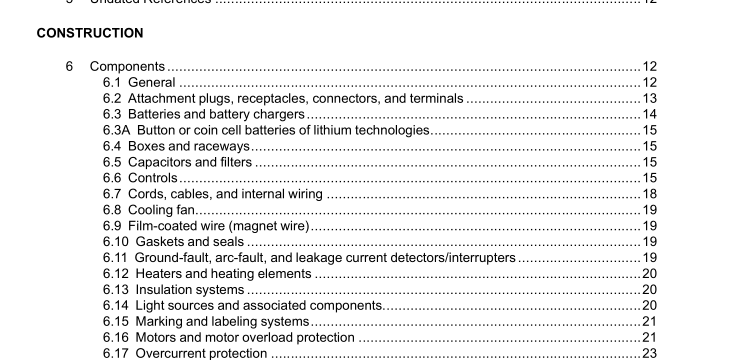UL 979-2020 pdf download.Water Treatment Appliances.
1 Scope 1.1 These requirements cover electrically operated water treatment appliances for household and commercial use. These appliances are intended for installation and use in accordance with the National Electrical Code, NFPA 70, and are rated 600 V or less. 1.2 These requirements cover appliances utilizing features that treat water through the use of cation exchange water softeners, ionization, filters, ultraviolet radiation, ozone generation, and reverse osmosis. 1.3 These requirements do not cover water treatment appliances for use with pools or spas, water distillers, aquariums, or other equipment connected to plumbing that is covered by individual requirements. 1.4 These requirements do not cover appliances for use in hazardous locations as defined in the National Electrical Code, NFPA 70. 1.5 These requirements do not cover the aesthetic effects or the effectiveness of water treatment. 2 Glossary 2.1 For the purpose of this standard the following definitions apply. 2.2 APPLIANCE – A collective term to designate all products covered by this Standard. 2.3 APPLIANCE COUPLER – A single-outlet, female contact device for attachment to a flexible cord as part of a detachable power-supply cord to be connected to an appliance inlet (motor attachment plug). 2.4 APPLIANCE INLET (MOTOR ATTACHMENT PLUG) – A male contact device mounted on an end product appliance to provide an integral blade configuration for the connection of an appliance coupler or cord connector.
2.8 APPLIANCE, STATIONARY – An appliance connected to plumbing and not expected to be moved except during servicing or storage. A stationary appliance may have wheels or casters. 2.9 BARRIER – A partition for the insulation or isolation of electric circuits, for the isolation of electric arcs, or for isolation of moving parts or hot surfaces. In this respect, a barrier may serve as a portion of an enclosure or as a functional part. 2.10 CAPACITOR, CLASS X – Capacitor or RC unit of a type suitable for use in situations where failure of the capacitor or RC unit would not lead to danger of electrical shock but could result in a risk of fire. Examples would be units connected phase to phase or phase to neutral. Notes: 1) X1 capacitors are generally used in circuits of permanently connected appliances. However, if the appliance is provided with a separate surge protective device that limits the impulse voltage to ≤ 2.5KV, an X2 capacitor is permitted. 2) X2 capacitors are generally used in circuits of cord-connected appliances. 2.11 CAPACITOR, CLASS Y – Capacitor or RC unit of a type suitable for use in situations where failure of the capacitor could lead to danger of electric shock. Examples would be capacitors connected across the primary and secondary circuits where electrical isolation is required to prevent an electric shock or between hazardous live parts and accessible parts. Notes: 1) Y1 capacitors are used in circuits where the prevention of electric shock is afforded solely by the isolation provided by the capacitor. Two Y2 capacitors connected in series is considered to provide the same level of protection as one Y1 capacitor. 2) Y2 capacitors are used where the prevention of electric shock is provided by the combination of the capacitor and earth ground for circuits operating at voltages ≥ 150Vand ≤ 300V. 3) Y4 capacitors are used where the prevention of electric shock is provided by the combination of the capacitor and earth ground for circuits operating at voltages ≤ 150V.
2.12 CIRCUIT, HIGH-VOLTAGE – A circuit involving a potential of more than 600 V. 2.13 CIRCUIT, LINE-VOLTAGE – A circuit involving a potential of not more than 600 V and having circuit characteristics in excess of those of a low-voltage circuit. 2.14 CIRCUIT, LOW-VOLTAGE – A circuit involving a peak open-circuit potential of not more than 42.4 V supplied by a primary battery, by a Class 2 transformer, or by a combination of a transformer and a fixed impedance that as a unit, complies with all performance requirements for a Class 2 transformer. A circuit derived from a line-voltage circuit by connecting a resistance in series with the supply circuit as a means of limiting the voltage and current, is not considered to be a low-voltage circuit.UL 979-2020 pdf download.
UL 979-2020 pdf download
